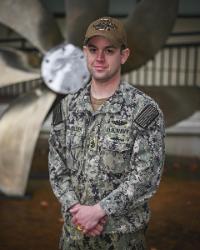
A Plymouth, Indiana, native is serving aboard USS Pennsylvania, one of the world’s most advanced nuclear-powered submarines.
Chief Petty Officer Kyle Borkholder joined the Navy 10 years ago. Today, Borkholder serves as a missile technician.
“I was inspired to join the Navy to serve my country,” said Borkholder.
Growing up in Plymouth, Borkholder was homeschooled and graduated in 2011. Today, Borkholder relies upon skills and values similar to those found in Plymouth to succeed in the military.
“The work ethic that my Dad taught me growing up is the biggest skill I brought with me to the military, and it's helped me become successful,” said Borkholder.
These lessons have helped Borkholder while serving in the Navy.
Known as America’s “Apex Predators!,” the Navy’s submarine force operates a large fleet of technically-advanced vessels. These submarines are capable of conducting rapid defensive and offensive operations around the world, in furtherance of U.S. national security.
There are three basic types of submarines: fast-attack submarines (SSN), ballistic-missile submarines (SSBN) and guided-missile submarines (SSGN).
Fast-attack submarines are designed to hunt down and destroy enemy submarines and surface ships; strike targets ashore with cruise missiles; carry and deliver Navy SEALs; conduct intelligence, surveillance, and reconnaissance missions; and engage in mine warfare. The Virginia-class SSN is the most advanced submarine in the world today. It combines stealth and payload capability to meet Combatant Commanders’ demands in this era of strategic competition.
The Navy's ballistic-missile submarines, often referred to as "boomers," serve as a strategic deterrent by providing an undetectable platform for submarine-launched ballistic missiles. SSBNs are designed specifically for stealth, extended patrols and the precise delivery of missiles. The Columbia-class SSBN will be the largest, most capable and most advanced submarine produced by the U.S. - replacing the current Ohio-class ballistic-missile submarines to ensure continuous sea-based strategic deterrence into the 2080s.
Guided-missile submarines provide the Navy with unprecedented strike and special operation mission capabilities from a stealthy, clandestine platform. Each SSGN is capable of carrying 154 Tomahawk cruise missiles, plus a complement of heavyweight torpedoes to be fired through four torpedo tubes.
Strategic deterrence is the nation’s ultimate insurance program, according to Navy officials. As a member of the submarine force, Borkholder is part of a rich 122-year history of the U.S. Navy’s most versatile weapons platform, capable of taking the fight to the enemy in the defense of America and its allies.
Serving in the Navy means Borkholder is part of a team that is taking on new importance in America’s focus on rebuilding military readiness, strengthening alliances and reforming business practices in support of the National Defense Strategy.
“The Navy is important to national defense because it ensures security to our country through its maritime superiority,” said Borkholder.
With more than 90 percent of all trade traveling by sea, and 95 percent of the world’s international phone and internet traffic carried through underwater fiber optic, Navy officials continue to emphasize that the prosperity and security of the United States is directly linked to a strong and ready Navy.
Borkholder and the sailors they serve with have many opportunities to achieve accomplishments during their military service.
“Crossing the international dateline was the accomplishment I'm most proud of,” said Borkholder.
As Borkholder and other sailors continue to train and perform missions, they take pride in serving their country in the United States Navy.
“Serving in the Navy provides job security, and it means being a part of something that is bigger than myself,” added Borkholder.






